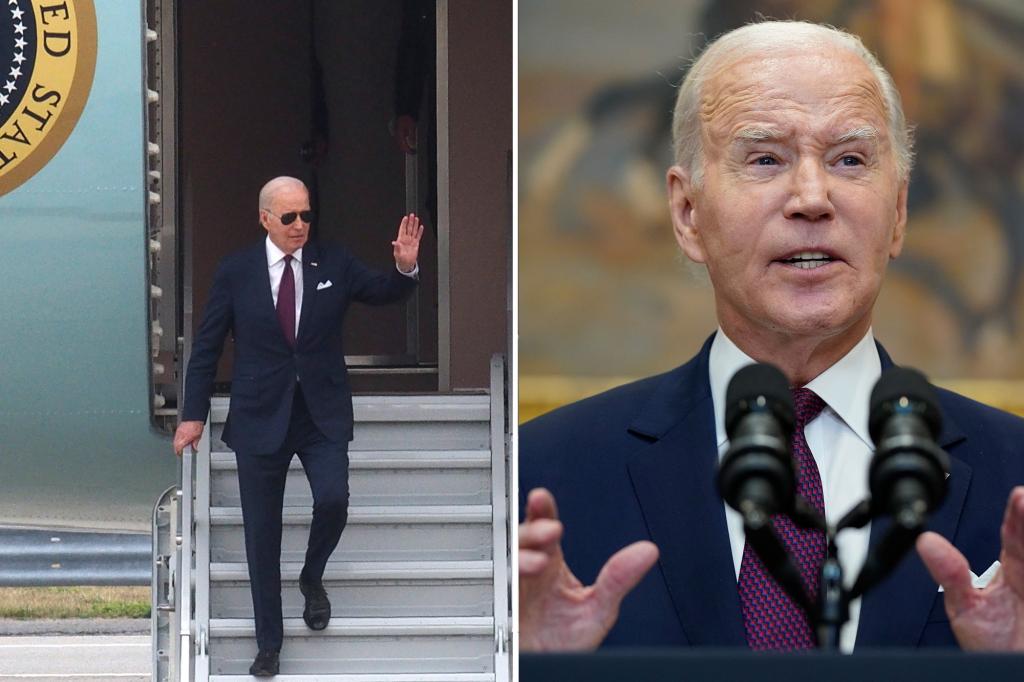This past week, President Biden decided to embark on a nationwide tour touting the extraordinary success of “Bidenomics.”
Seriously.
With the 2024 campaign gearing up, the president is presenting more of a public relations blitz attacking his predecessors than a serious examination of his own economic record.
In one speech, Biden derisively repeated the “trickle-down” straw man 15 times, which exceeded his combined mentions of his own record on inflation, wages and the stock market.
Perhaps distraction was the president’s best option, given the public’s 36% approval rating of an economic record dominated by soaring federal debt, surging inflation and stagnant real incomes.
Runaway spending
Start with the runaway spending and bailouts enacted by a unified Democratic government that will cost $5 trillion over the decade. Annual budget deficits — less than $1 trillion before the pandemic — are now projected to approach $3 trillion within a decade.
President Biden brags that he “reduced the deficit by $1.7 trillion — more than any president has just in two years.”

In reality, he let $2 trillion in pandemic spending expire on schedule, and then added $300 billion in new spending of his own, leaving the yearly deficit nearly 40% above pre-pandemic levels. Equally disingenuous is the claim that the president’s new budget proposes $2.5 trillion in 10-year deficit reduction — which was measured by simply not counting trillions in proposed tax cut extensions.
Much of the enacted spending — particularly the $1.9 trillion American Rescue Plan — drove modest post-pandemic inflation into an economic crisis.
Disregarding warnings from liberal economists like Lawrence Summers, this spending spree played a key role in driving prices upward by more than 16% in the 30 months since the president took office, at a cost of more than $10,000 for the typical household.
Even as the inflation rate normalizes, it will not undo the recent price increases that have rendered many goods and services unaffordable for many families.
This inflation exceeded wage growth and caused families to fall further behind. Since Biden took office, hourly compensation (adjusted for inflation) has fallen by 5%. When incomes cannot keep pace with inflation and families are falling behind, few other economic variables matter.
The president frames his economic agenda as obsessively focused on building the middle class. Yet it’s the middle class that has been slammed by rising inflation and declining incomes.

Middle class slammed
Additionally, home buyers have been hit with both rising mortgage rates (from 2.8% to 6.7%) and rising home prices (by 22%) — nearly doubling the monthly mortgage on a new median-priced home from $1,174 to $2,271.
The stock market performed well in 2021, yet has fallen nearly 10% since the beginning of 2022. Even mortgage, auto and credit card debt — which temporarily declined due to large pandemic stimulus payments — are once again rising.
The president highlights the 13 million new jobs added since he took office. However, most were the natural job returns after the pandemic lockdowns were lifted.
And the additional progress toward the current 3.7% unemployment rate — while impressive — is driven by the inflationary overheating of the economy. One cannot take credit for the faster job growth without also owning the inflation that the same policies brought.
And despite President Biden’s relentless rhetoric on inequality, the Census Bureau reports that economic inequality is now rising for the first time since 2011.
Steep inflation, declining real incomes, a falling stock market and deepening inequality. Not usually cause for a presidential victory lap.
Still, the president frames Bidenomics as chiefly pursuing policies that are “pro-worker” and “pro-investment.” Instead, his policies resuscitate long-rejected big government failures.
The “pro-worker” push has meant aggressively catering to big labor with tariffs, protectionism, Buy America rules, union bailouts and expensive red tape.
Industry handouts
Many of these policies are designed to aggressively raise labor costs and to shield favored industries from competition. This has hampered American competitiveness, worsened inflation, angered our trading partners and risked retaliation against America’s export industries.
The supposedly “pro-investment” policies have taken the form of aggressive industrial policies to pick winners and losers, further limit competition and spend massively on corporate welfare.

For example, the CHIPS Act appropriated $52 billion purportedly to lower production costs and thus encourage domestic superconductor production.
Instead, the Biden administration saddled the manufacturers with expensive child care mandates and refused to reform expensive construction and labor regulations. Consequently, planned manufacturing plants have been canceled and delayed.
The $370 billion infrastructure law has also run into massive regulatory delays and union-sought cost increases. And the Inflation Reduction Act’s handouts for clean energy projects are now projected to run as much as 2,686% over budget.
All in all, Bidenomics relies on vast subsidies and regulations to shield favored industries from competition, at the expense of consumers and taxpayers. It’s a spoils system for big labor and politically connected industries.
Given the soaring federal debt, steep inflation and falling incomes, its no wonder that the president would rather criticize “trickle-down” straw men than defend his economic record.
Brian Riedl is a senior fellow at the Manhattan Institute. Follow him on Twitter @Brian_Riedl.
𝗖𝗿𝗲𝗱𝗶𝘁𝘀, 𝗖𝗼𝗽𝘆𝗿𝗶𝗴𝗵𝘁 & 𝗖𝗼𝘂𝗿𝘁𝗲𝘀𝘆: nypost.com
𝗙𝗼𝗿 𝗮𝗻𝘆 𝗰𝗼𝗺𝗽𝗹𝗮𝗶𝗻𝘁𝘀 𝗿𝗲𝗴𝗮𝗿𝗱𝗶𝗻𝗴 𝗗𝗠𝗖𝗔,
𝗣𝗹𝗲𝗮𝘀𝗲 𝘀𝗲𝗻𝗱 𝘂𝘀 𝗮𝗻 𝗲𝗺𝗮𝗶𝗹 𝗮𝘁 dmca@enspirers.com


